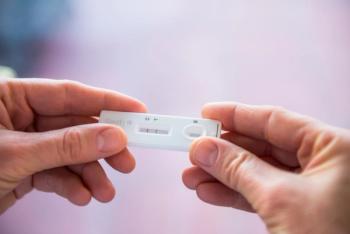
- Consultant for Pediatricians Vol 5 No 5
- Volume 5
- Issue 5
Photoclinic: Catscratch Disease
Photoclinic: Catscratch Disease This 12-year-old girl had a persistent, nontender enlarged lymph node in the right groin. After the lymphadenopathy had failed to respond to antibiotic therapy, pathologic examination of the lymph node established the diagnosis of catscratch disease. The child remembered that she had been scratched on the right calf by a cat the month before; the scratch had already healed when the lymph node appeared. This child had no symptoms other than lymph node enlargement; however, systemic symptoms of fever, malaise, and headache may occur 2 to 3 weeks after a cat scratch. Spontaneous node regression usually occurs within 4 weeks writes Barbara Barlow, MD, of New York, NY.
This 12-year-old girl had a persistent, nontender enlarged lymph node in the right groin. After the lymphadenopathy had failed to respond to antibiotic therapy, pathologic examination of the lymph node established the diagnosis of catscratch disease. The child remembered that she had been scratched on the right calf by a cat the month before; the scratch had already healed when the lymph node appeared. This child had no symptoms other than lymph node enlargement; however, systemic symptoms of fever, malaise, and headache may occur 2 to 3 weeks after a cat scratch. Spontaneous node regression usually occurs within 4 weeks writes Barbara Barlow, MD, of New York, NY.
Articles in this issue
over 19 years ago
Otitis Media With Acute Palsy of the Seventh Cranial Nerveover 19 years ago
Sialoadenitis in a Teenagerover 19 years ago
Photoclinic: Arachnoid Cystover 19 years ago
Photo Quiz: Blame the Family Pet for These Rashes?over 19 years ago
Case in Point: Acute Osteomyelitis: Radiographs Versus MRIover 19 years ago
Dog Bite in a Penicillin-Allergic Patientover 19 years ago
Consultations & Comments: Acetaminophen and Asthma: Any Connection?over 19 years ago
Photoclinic: Peroneal Ganglionover 19 years ago
Photoclinic: Varicella-Zoster Infectionover 19 years ago
Fractures From Short Falls: Implications in Children Under Age 5Newsletter
Access practical, evidence-based guidance to support better care for our youngest patients. Join our email list for the latest clinical updates.














